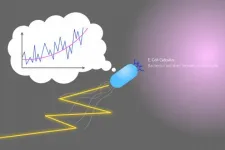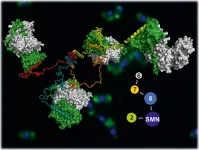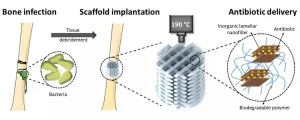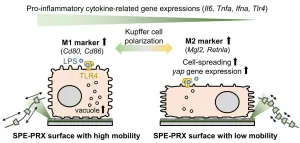Wafer-thin nanopaper changes from firm to soft at the touch of a button
Bioinspired cellulose nanofibrils can be controlled by electricity / Strength and stiffness can be modulated via an electrical switch
2021-03-24
(Press-News.org) Materials science likes to take nature and the special properties of living beings that could potentially be transferred to materials as a model. A research team led by chemist Professor Andreas Walther of Johannes Gutenberg University Mainz (JGU) has succeeded in endowing materials with a bioinspired property: Wafer-thin stiff nanopaper instantly becomes soft and elastic at the push of a button. "We have equipped the material with a mechanism so that the strength and stiffness can be modulated via an electrical switch," explained Walther. As soon as an electric current is applied, the nanopaper becomes soft; when the current flow stops, it regains its strength. From an application perspective, this switchability could be interesting for damping materials, for example. The work, which also involved scientists from the University of Freiburg and the Cluster of Excellence on "Living, Adaptive, and Energy-autonomous Materials Systems" (livMatS) funded by the German Research Foundation (DFG), was published in Nature Communications.
Inspiration from the seafloor: Mechanical switch serves a protective function
The nature-based inspiration in this case comes from sea cucumbers. These marine creatures have a special defense mechanism: When they are attacked by predators in their habitat on the seafloor, sea cucumbers can adapt and strengthen their tissue so that their soft exterior immediately stiffens. "This is an adaptive mechanical behavior that is fundamentally difficult to replicate," said Professor Andreas Walther. With their work now published, his team has succeeded in mimicking the basic principle in a modified form using an attractive material and an equally attractive switching mechanism.
The scientists used cellulose nanofibrils extracted and processed from the cell wall of trees. Nanofibrils are even finer than the microfibers in standard paper and result in a completely transparent, almost glass-like paper. The material is stiff and strong, appealing for lightweight construction. Its characteristics are even comparable to those of aluminum alloys. In their work, the research team applied electricity to these cellulose nanofibril-based nanopapers. By means of specially designed molecular changes, the material becomes flexible as a result. The process is reversible and can be controlled by an on/off switch.
"This is extraordinary. All the materials around us are not very changeable, they do not easily switch from stiff to elastic and vice versa. Here, with the help of electricity, we can do that in a simple and elegant way," said Walther. The development is thus moving away from classic static materials toward materials with properties that can be adaptively adjusted. This is relevant for mechanical materials, which can thus be made more resistant to fracture, or for adaptive damping materials, which could switch from stiff to compliant when overloaded, for example.
Targeting a material with its own energy storage for autonomous on/off switching
At the molecular level, the process involves heating the material by applying a current and thus reversibly breaking cross-linking points. The material softens in correlation with the applied voltage, i.e., the higher the voltage, the more cross-linking points are broken and the softer the material becomes. Professor Andreas Walther's vision for the future also starts at the point of power supply: While currently a power source is needed to start the reaction, the next goal would be to produce a material with its own energy storage system, so that the reaction is essentially triggered "internally" as soon as, for example, an overload occurs and damping becomes necessary. "Now we still have to flip the switch ourselves, but our dream would be for the material system to be able to accomplish this on its own."
INFORMATION:
Andreas Walther conducted his research in close collaboration with his colleagues at the University of Freiburg. He is one of the founders of the Freiburg Cluster of Excellence on "Living, Adaptive, and Energy-autonomous Materials Systems" (livMatS), in which he will continue to be involved as an associate researcher. Since October 2020, Walther has been Professor of Macromolecular Chemistry at Johannes Gutenberg University Mainz and he is also a Fellow of JGU's Gutenberg Research College (GRC). For his project entitled "Metabolic Mechanical Materials: Adaptation, Learning & Interactivity" (M3ALI), he received an ERC Consolidator Grant, one of the most highly endowed EU funding awards given to top-level researchers.
ELSE PRESS RELEASES FROM THIS DATE:
2021-03-24
Tokyo, Japan - Scientists from the Graduate School of Information Science and Technology at The University of Tokyo calculated the efficiency of the sensory network that bacteria use to move towards food and found it to be optimal from an information theory standpoint. This work may lead to a better understanding of bacterial behavior and their sensory networks.
Despite being single-celled organisms, bacteria such as E. Coli can perform some impressive feats of sensing and adaptation in constantly changing environmental conditions. For example, these bacteria can sense the presence of a chemical ...
2021-03-24
Imbued with special electric, mechanical and other physical properties due to their tiny size, nanofibers are considered leading-edge technology in biomedical engineering, clean energy and water quality control, among others. Now, researchers in Italy and UK have developed an automatic process to assess nanofiber fabrication quality, producing 30% more accurate results than currently used techniques.
Details were published on January 2021 in IEEE/CAA Journal of Automatica Sinica, a joint publication of the IEEE and the Chinese Association of Automation.
"In recent years, nanostructured materials have gained continuously growing interest both in scientific and industrial contexts, because of their research appeal and versatile applications," ...
2021-03-24
SMN or in full Survival Motor Neuron: Professor Utz Fischer has been analyzing this protein and the large molecular complex of the same name, of which SMN is one of the building blocks, for many years. He holds the Chair of the Department of Biochemistry at the Julius-Maximilian's University of Würzburg (JMU), and he first discovered the molecule during his search for the root cause of spinal muscular atrophy. As scientists found out a few years ago, this disease is caused by a lack of the SNM complex.
The work group around Prof. Fischer has now succeeded in presenting a first three-dimensional model of the ...
2021-03-24
In a ground-breaking first, researchers have fabricated 3D scaffold implants containing antibiotics at high temperatures. These scaffolds not only support bone regeneration but manage the bone infections that can arise as a result of injury or surgery.
Each year, around 4 million people worldwide develop bone infection following an open fracture or surgery. The gold standard treatment consists of a lengthy antibiotic therapy, usually delivered orally or Intravenously, and the removal of infected bone tissue, which often leaves behind a hole too large for the body to fill via normal bone regeneration. In a study published in the KeAi journal Bioactive Materials, a group of researchers from the Netherlands, Italy and Spain, outline a new treatment ...
2021-03-24
A genetic variation that regulates iron metabolism may enhance athletes' endurance performance, researchers at the University of Toronto have shown.
The findings could help explain studies that show an association between the genetic variation and elite athletes across many sports, and may help competitive athletes fine-tune their iron intake to boost performance.
The variation, found in the homeostatic iron regulator (HFE) gene, is a known cause of iron overload, a condition called hemochromatosis in which the body absorbs too much iron leading to organ and joint damage.
Athletes at risk for hemochromatosis but with iron stores below potentially toxic levels could have ...
2021-03-24
Bacteria plucked from a desert plant could help crops survive heatwaves and protect the future of food.
Global warming has increased the number of severe heatwaves that wreak havoc on agriculture, reduce crop yields and threaten food supplies. However, not all plants perish in extreme heat. Some have natural heat tolerance, while others acquire heat tolerance after previous exposure to higher temperatures than normal, similar to how vaccines trigger the immune system with a tiny dose of virus.
But breeding heat tolerant crops is laborious and expensive, and slightly warming entire fields is even trickier.
There is growing interest in harnessing microbes to protect plants, and biologists have shown that root-dwelling bacteria can help their herbaceous ...
2021-03-24
Researchers from Tokyo Medical and Dental University (TMDU) identify biomaterials that can be used to modulate liver immune cell behavior
Tokyo, Japan - Biomaterials are substances, natural or manmade, that are used in medicine to interact with the human body for various purposes, such as wound healing and tissue regeneration. Previous work on biomaterials has shown that they can affect cells in many ways, including how they grow, move, and the type of cell they develop into. Scientists have recently begun investigating biomaterials with properties that can be fine-tuned to optimize their use in regenerative ...
2021-03-24
Usually scaled, the skin of fish can also be naked or made up of bony plates that form an armour, sometimes even covered with teeth. But how has this skin evolved over the ages? To answer this question, researchers at the University of Geneva (UNIGE), Switzerland, have reconstructed the evolution of the protective skin structures in fish, going back to the common ancestor of ray-finned fish, more than 420 million years ago. They found that only fish that had lost their scales were able to develop a bony armour, and that the protective state of their skin influenced their choice of open water or sea floor habitats. This study, published in the journal Evolution Letters, provides a new explanation for the incredible ...
2021-03-24
In spring 2020, when the first wave of the coronavirus pandemic hit Finland, older adults drastically reduced their out-of-home activities. During the period of government restrictions, physical exercise was the most common reason to leave home, a recent study at the University of Jyväskylä Faculty of Sport and Health Sciences finds.
"In spring 2020, it was feared that the closure of many activity destinations and the recommendations to avoid close contact with persons from other households put in place by the government would decrease physical activity levels, and thus, negatively affect older adults' physical functional capacity," Senior ...
2021-03-24
The tiger shark is one of the largest predatory sharks known today. This shark is a cosmopolitan species occurring in all oceans worldwide. It is characterized by a striped pattern on its back, which is well marked in juveniles but usually fades in adults.
The fossil history of modern sharks reaches back to the Permian, about 295 million years ago. Complete fossil shark skeletons are very rare - the skeleton, which consists almost entirely of cartilage, is only preserved under very special circumstances during the fossilization processes. Due to the lifelong continuous tooth replacement, most extinct sharks are therefore only known by their well-mineralized teeth, which, nonetheless, can provide deep insights into their evolutionary history.
The ...
LAST 30 PRESS RELEASES:
[Press-News.org] Wafer-thin nanopaper changes from firm to soft at the touch of a button
Bioinspired cellulose nanofibrils can be controlled by electricity / Strength and stiffness can be modulated via an electrical switch







